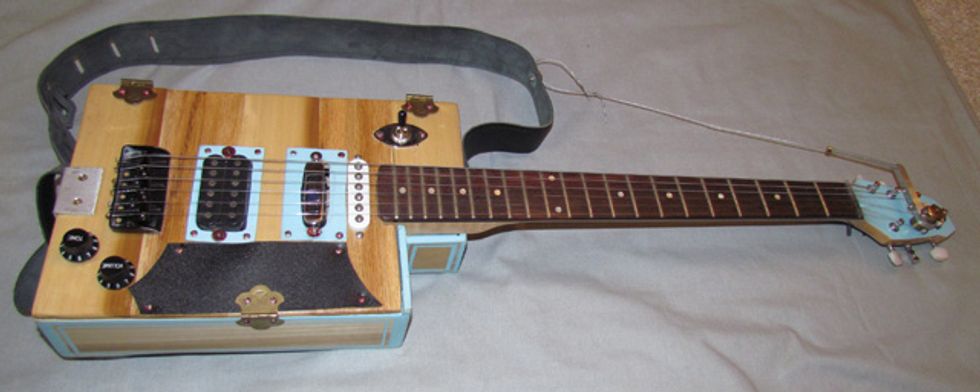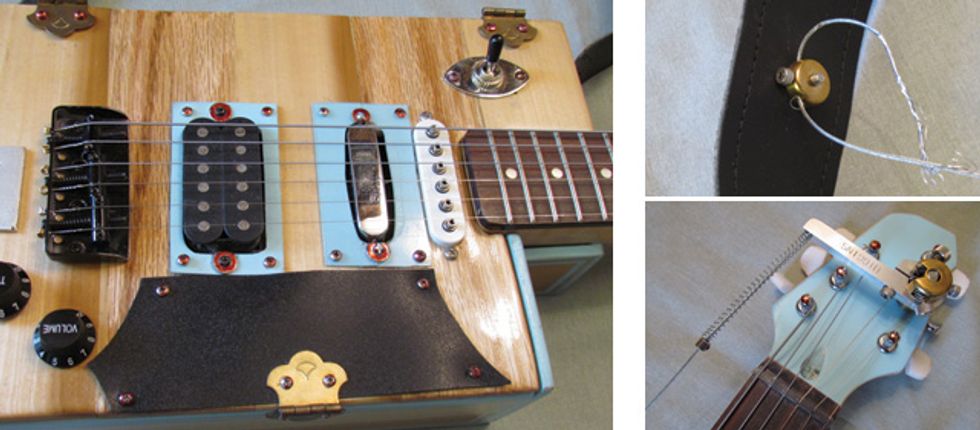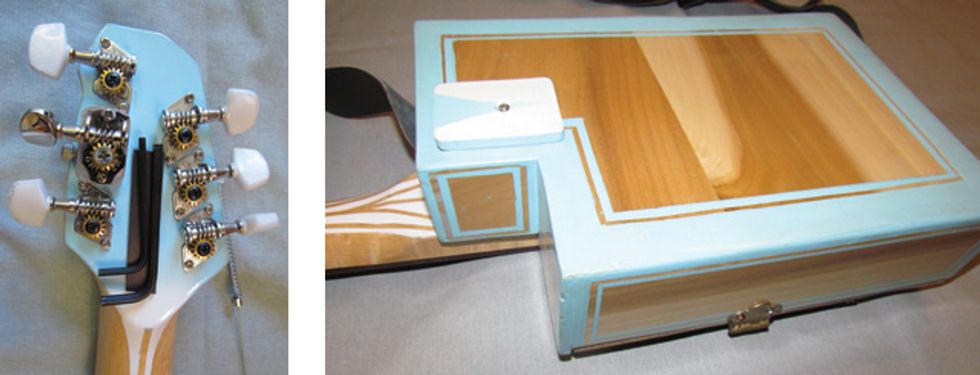This cigar-box guitar features a 3" deep body, funky pinstriping, and—believe it or not—a Higgins B-bender.
Several years ago I was bitten by the cigar-box guitar bug. There’s something wonderfully earthy about CBGs. Most are one-of-a-kind handmade instruments built simply for fun. They express someone’s creativity—usually with a twist of weirdness thrown in. Note: Not all CBGs are actually made out of cigar boxes. Rather, many are crafted to look like a cigar box with a squarish shape and hinged lid.
LEFT: The G&L S-500 neck pickup
is a new addition. The Tele-style pickup arrived
DOA and while operative, the bridge humbucker’s
origin remains a mystery. TOP RIGHT: One end
of the bender’s cable attaches to a pulley on the
shoulder strap. BOTTOM RIGHT: The Higgins bender mechanism
mounts on the face of the headstock.
A few years ago, this CBG caught my eye on eBay because it kind of resembled a jazz guitar with its deep 3" body, cutaway, and fetching trim. I scored it for $128, but like most CBGs, I knew it would probably have some issues—and it did. The Tele-style neck pickup was dead, the bridge completely unusable, and the wiring was a mess. So I made a trip to Asheville (North Carolina) guitar guru Jack Dillen to seek help.
Fortunately, I keep a wide assortment of parts handy. To reduce repair costs, I brought Jack a spare G&L S-500 pickup and a shortened black Tele-style 3-saddle bridge. Because the dead neck pickup looked cool, I asked him to leave it where it was and mount the S-500 close to the neck.
Now that would be enough to keep most techs busy, but I also asked Jack to install a Higgins B-Bender I’d just acquired in a trade. There’s not much real estate on a CBG to mount most benders, so the Higgins seemed a logical choice for me. It works by pulling downwards on the supplied strap, which activates a cable that attaches to the bender mechanism on the headstock. Crazy!
LEFT: Two allen wrenches adjust the movement of the pull-string cam. RIGHT: The blue-and-white trim adds a folksy flair.
A week and $50 later, Jack had my CBG ready. I was surprised by how easy it is to play. The new neck pickup has a nice jazzy twang and the bridge humbucker delivers plenty of beef and volume. The Higgins is a trip to use but definitely has a learning curve. It also requires daily tweaking with different allen wrenches, so I added a magnetic strip behind the headstock to keep these tools handy. The Higgins uses a different motion than I’m used to, so I’m still learning how to pull it smoothly, but it’s so cool to have a bender on a CBG.
So is this a keeper? It has to be. I have too much invested for me to ever come close to getting my money back by selling it.
Bottom Feeder Tip #221: Never modify a guitar thinking you’ll be able to recoup your expenses later. It seldom works out that way. For every dollar you spend on mods, you usually get back only 20–50 cents on resale. But if modifying a guitar means the difference between playing it or not, I always err on the side of playing. Guitars need to be played, not hung on a wall.
 Will Ray
is a founding
member of the
Hellecasters guitar-twang
trio. He also does guitar
clinics promoting his
namesake G&L signature
model 6-string, and produces
artists and bands at his studio in
Asheville, North Carolina. You can contact
Will on Facebook and at willray.biz.
Will Ray
is a founding
member of the
Hellecasters guitar-twang
trio. He also does guitar
clinics promoting his
namesake G&L signature
model 6-string, and produces
artists and bands at his studio in
Asheville, North Carolina. You can contact
Will on Facebook and at willray.biz.









![Rig Rundown: Russian Circles’ Mike Sullivan [2025]](https://www.premierguitar.com/media-library/youtube.jpg?id=62303631&width=1245&height=700&quality=70&coordinates=0%2C0%2C0%2C0)

















